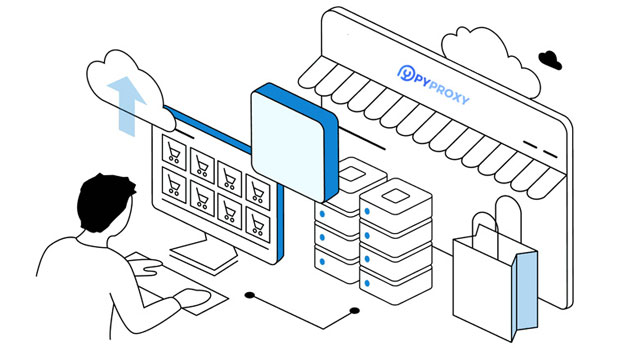In today's digital world, the demand for secure, reliable, and high-performance proxy services is on the rise. PYPROXY stands out as a leading proxy service provider, offering top-tier solutions that guarantee high availability and automatic filtering for a seamless internet experience. These key features ensure that users can access content securely while protecting their data from potential threats. This article will explore the benefits of high availability and automatic filtering in PyProxy’s services, and how these features add value for businesses and individual users alike. Understanding High Availability in Proxy ServicesHigh availability refers to the ability of a system or service to remain operational without interruptions over a long period. For proxy services, this means ensuring that users can maintain a stable, continuous connection without experiencing downtime or slow speeds. For businesses relying on proxies for critical tasks, such as data scraping, web browsing, and content access, high availability is non-negotiable.PyProxy’s approach to high availability ensures that their proxy network is distributed across multiple servers and data centers. This geographical distribution helps mitigate the risk of downtime caused by server failures or network congestion. Additionally, load balancing technologies are employed to direct traffic efficiently across servers, reducing latency and ensuring optimal performance.By maintaining a highly redundant and fault-tolerant infrastructure, PyProxy can offer users an uninterrupted service, even in the face of hardware failures, network issues, or other unexpected disruptions.The Importance of Automatic Filtering in Proxy ServicesAutomatic filtering is another essential feature that sets PyProxy apart from many other proxy service providers. This feature automatically analyzes and filters incoming and outgoing data to ensure that only relevant and safe content is accessed. For individuals and businesses that rely on proxies for secure browsing or online activities, filtering is crucial for enhancing security and maintaining the integrity of online interactions.In PyProxy’s case, the filtering process is powered by advanced algorithms that can detect and block malicious content, such as malware, phishing attempts, and other types of cyber threats. By automatically filtering harmful data, PyProxy helps protect users from potential security breaches and ensures a safe browsing experience.Moreover, PyProxy’s filtering system can be customized based on user needs. Whether it’s blocking specific types of content, filtering out ads, or allowing access only to trusted sites, the service provides flexible and dynamic filtering options. This not only enhances security but also improves the overall browsing experience by reducing unwanted content and distractions.How High Availability and Automatic Filtering Work TogetherWhen combined, high availability and automatic filtering create a robust proxy service that ensures both performance and security. High availability ensures that users can access the service without interruptions, while automatic filtering ensures that the data they receive is safe and relevant. Together, these features allow users to enjoy a seamless, secure, and uninterrupted internet experience.For example, if a user is accessing a website through PyProxy, high availability ensures that the connection remains stable and fast, even if the website experiences heavy traffic or if there are issues with certain servers. At the same time, the automatic filtering system ensures that the content being accessed is secure, blocking any malicious elements before they reach the user’s device.The Advantages of PyProxy’s Top-Tier Proxy Services for BusinessesBusinesses, particularly those involved in data scraping, competitive analysis, or e-commerce, rely heavily on proxy services to perform tasks like collecting data, managing multiple accounts, and accessing geo-restricted content. PyProxy’s top-tier services provide several benefits for these businesses.1. Data Security: With automatic filtering blocking malware and phishing attacks, businesses can trust that their sensitive data is protected. This reduces the risk of data breaches and cyberattacks, which could lead to significant financial losses and reputational damage.2. Reduced Downtime: High availability ensures that businesses don’t face interruptions that could impact their operations. Whether it’s a critical research project or a marketing campaign, having a proxy service that is always online is crucial for maintaining smooth business operations.3. Geo-Specific Content Access: By using high-performance proxies with global server distribution, businesses can easily access geo-restricted content. This is especially important for businesses operating in different regions or needing to gather data from websites that restrict access based on location.4. Scalability: As businesses grow, their need for proxy services can increase. PyProxy’s infrastructure is designed to scale seamlessly, ensuring that businesses can continue to use the service without performance degradation, even as their data needs expand.The Benefits for Individual UsersWhile businesses benefit from high availability and automatic filtering, individual users also stand to gain a lot from PyProxy’s services. The combination of performance and security features makes it an excellent choice for anyone looking to improve their online experience.1. Privacy and Anonymity: By using proxies to mask their IP addresses, users can browse the internet anonymously, protecting their privacy and preventing websites from tracking their online activities. This is particularly useful for those concerned about their digital footprint.2. Safe Browsing: Automatic filtering ensures that users avoid dangerous websites and content. Whether it’s blocking malicious ads, harmful downloads, or unwanted pop-ups, PyProxy’s filtering system helps users stay safe while browsing.3. Access to Restricted Content: Many users rely on proxies to access content that is restricted in their region. Whether it’s streaming services, news websites, or social media platforms, PyProxy’s high availability and global server network make it easy for users to bypass geo-restrictions and access the content they need.4. Reduced Risk of Cyberattacks: By filtering out harmful content, PyProxy provides an additional layer of defense against online threats. Whether it’s phishing attacks, malicious software, or other types of cybercrime, users are better protected when using a service with automatic filtering.PyProxy’s top-tier proxy services provide a compelling solution for both businesses and individual users. With high availability ensuring uninterrupted service and automatic filtering enhancing security, users can enjoy a fast, safe, and seamless online experience. Whether it’s for protecting sensitive data, accessing restricted content, or improving browsing performance, PyProxy’s proxy services deliver significant value and are well-suited for today’s digital landscape.By combining cutting-edge technology with a focus on security, performance, and reliability, PyProxy sets a new standard in the proxy service industry.
Nov 14, 2025



































































